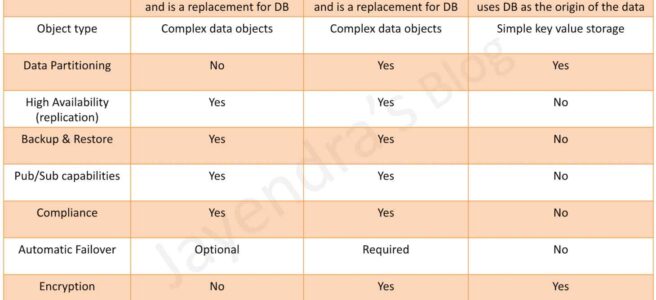AWS ElastiCache Redis vs Memcached
ElastiCache supports the Memcached and Redis cache engines. Each engine provides some advantages and ElastiCache Redis vs Memcached provides the key differences between the two engines.

Memcached
- Need the simplest model possible.
- Need to run large nodes with multiple cores or threads.
- Need the ability to scale out and in, adding and removing nodes as demand on the system increases and decreases.
- Need to cache objects.
Redis
- Need complex data types, such as strings, hashes, lists, sets, sorted sets, and bitmaps.
- Need to sort or rank in-memory datasets.
- Need persistence of the key store.
- Need to replicate the data from the primary to one or more read replicas for read-intensive applications.
- Need automatic failover if the primary node fails.
- Need publish and subscribe (pub/sub) capabilities – to inform clients about events on the server.
- Need backup and restore capabilities.
- Need to support multiple databases.
- Need Encryption at Rest and in Transit.
- Need the ability to dynamically add or remove shards from the Redis (cluster mode enabled) cluster.
- Need to authenticate users with role-based access control.
- Need geospatial indexing (clustered mode or non-clustered mode)
- Need to meet compliance requirements – HIPPA, FedRAMP, PCI-DSS.
AWS Certification Exam Practice Questions
- Questions are collected from Internet and the answers are marked as per my knowledge and understanding (which might differ with yours).
- AWS services are updated everyday and both the answers and questions might be outdated soon, so research accordingly.
- AWS exam questions are not updated to keep up the pace with AWS updates, so even if the underlying feature has changed the question might not be updated
- Open to further feedback, discussion and correction.
- A company wants to implement best practices on AWS. Which implementation would help eliminate “Single Point of failure”?
- ElastiCache Memcached deployment
- RDS Single-AZ deployment
- EC2 instances on a single AZ
- ElastiCache Redis deployment
-
You are launching your first ElastiCache cache cluster, and start using Memcached. Which of the following is NOT a key feature of Memcached?
- You need the ability to scale your Cache horizontally as you grow.
- You use more advanced data types, such as lists, hashes, and sets.
- You need a simple caching model as possible.
- Object caching is your primary goal to offload your database.
